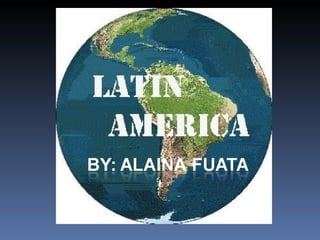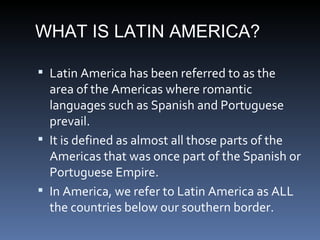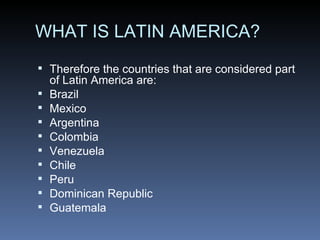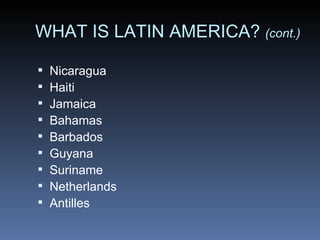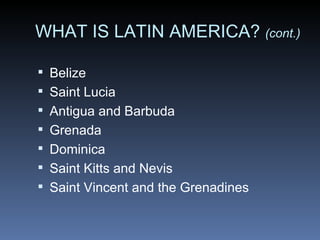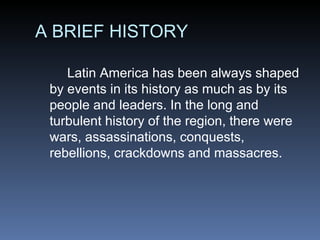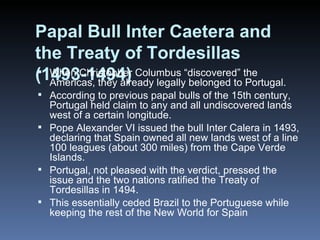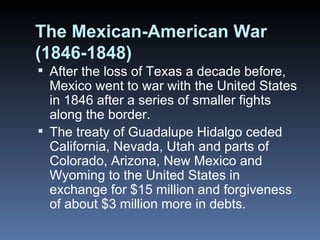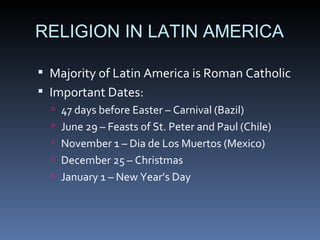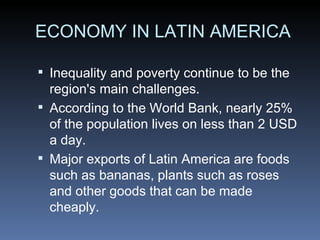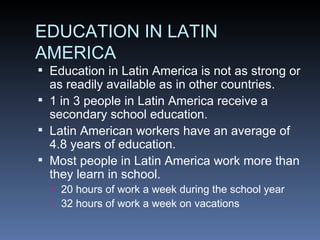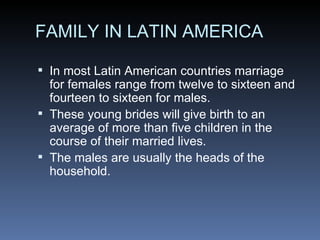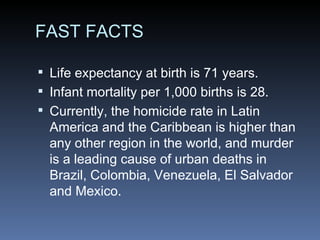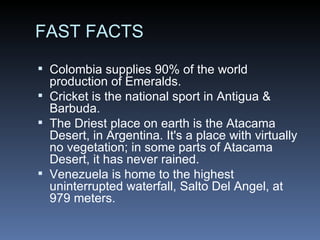L A T I N A M E R I C A
- 1. Ěý
- 2. WHAT IS LATIN AMERICA? Latin America has been referred to as the area of the Americas where romantic languages such as Spanish and Portuguese prevail. It is defined as almost all those parts of the Americas that was once part of the Spanish or Portuguese Empire. In America, we refer to Latin America as ALL the countries below our southern border.
- 3. WHAT IS LATIN AMERICA? Therefore the countries that are considered part of Latin America are: Brazil Mexico Ěý Argentina Colombia Ěý Venezuela Ěý Chile Ěý Peru Ěý Dominican Republic Ěý Guatemala Ěý
- 4. WHAT IS LATIN AMERICA? (cont.) Ecuador Ěý Costa Rica Ěý Cuba Ěý Uruguay Ěý El Salvador Ěý Paraguay Ěý Bolivia Ěý Panama Ěý Honduras Ěý Trinidad and Tobago Ěý
- 5. WHAT IS LATIN AMERICA? (cont.) Nicaragua Ěý Haiti Ěý Jamaica Ěý Bahamas Ěý Barbados Ěý Guyana Ěý Suriname Ěý Netherlands Antilles Ěý
- 6. WHAT IS LATIN AMERICA? (cont.) Belize Ěý Saint Lucia Ěý Antigua and Barbuda Ěý Grenada Ěý Dominica Ěý Saint Kitts and Nevis Ěý Saint Vincent and the Grenadines
- 7. A BRIEF HISTORY Latin America has been always shaped by events in its history as much as by its people and leaders. In the long and turbulent history of the region, there were wars, assassinations, conquests, rebellions, crackdowns and massacres.
- 8. Papal Bull Inter Caetera and the Treaty of Tordesillas (1493-1494) When Christopher Columbus “discovered” the Americas, they already legally belonged to Portugal. According to previous papal bulls of the 15th century, Portugal held claim to any and all undiscovered lands west of a certain longitude. Pope Alexander VI issued the bull Inter Calera in 1493, declaring that Spain owned all new lands west of a line 100 leagues (about 300 miles) from the Cape Verde Islands. Portugal, not pleased with the verdict, pressed the issue and the two nations ratified the Treaty of Tordesillas in 1494. This essentially ceded Brazil to the Portuguese while keeping the rest of the New World for Spain
- 9. The Conquest of the Aztec and Inca Empires (1519-1533) The Spanish realized that Latin America was a valuable resource and should be colonized. The only things standing in their way were the powerful empires of the Aztecs and Incas. Ruthless conquistadores under the command of Hernan Cortes in Mexico and Francisco Pizarro in Peru paved the way for centuries of Spanish rule and enslavement and marginalization of New World natives.
- 10. The Mexican-American War (1846-1848) After the loss of Texas a decade before, Mexico went to war with the United States in 1846 after a series of smaller fights along the border. The treaty of Guadalupe Hidalgo ceded California, Nevada, Utah and parts of Colorado, Arizona, New Mexico and Wyoming to the United States in exchange for $15 million and forgiveness of about $3 million more in debts.
- 11. GOVERNMENT IN CUBA The Constitution of 1976, which defined Cuba as a socialist republic, was replaced by the Constitution of 1992, which is guided by the ideas of JosĂ© MartĂ, Marx, Engels and Lenin. The constitution describes the Communist Party of Cuba as the "leading force of society and of the state". No political party is permitted to nominate candidates or campaign on the island
- 12. GOVERNMENT IN VENEZUELA Federal Republic There are five branches of government: Executive, Legislative, Judicial, Citizen, and Electoral. The citizens branch consists of three componentsĚý– the prosecutor general, the "defender of the people" or ombudsman, and the controller general. These officers, in addition to fulfilling their specific functions, also act collectively to submit to the Supreme Tribunal actions they believe are illegal, particularly those which violate the Constitution. The holders of the "citizen power" offices are selected for terms of 7 years by the National Assembly. The Electoral council is responsible for organizing elections at all levels. Its members are elected to seven-year terms by the National Assembly
- 13. RELIGION IN LATIN AMERICA Majority of Latin America is Roman Catholic Important Dates: 47 days before Easter – Carnival (Bazil) June 29 – Feasts of St. Peter and Paul (Chile) November 1 – Dia de Los Muertos (Mexico) December 25 – Christmas January 1 – New Year’s Day
- 14. ECONOMY IN LATIN AMERICA Inequality and poverty continue to be the region's main challenges. According to the World Bank, nearly 25% of the population lives on less than 2 USD a day. Major exports of Latin America are foods such as bananas, plants such as roses and other goods that can be made cheaply.
- 15. EDUCATION IN LATIN AMERICA Education in Latin America is not as strong or as readily available as in other countries. 1 in 3 people in Latin America receive a secondary school education. Latin American workers have an average of 4.8 years of education. Most people in Latin America work more than they learn in school. 20 hours of work a week during the school year 32 hours of work a week on vacations
- 16. FAMILY IN LATIN AMERICA In most Latin American countries marriage for females range from twelve to sixteen and fourteen to sixteen for males. These young brides will give birth to an average of more than five children in the course of their married lives. The males are usually the heads of the household.
- 17. In most Latin American countries, basic resources such as water are hard to come by. Majority of the people in these nations are living in poverty and categorized as the working poor. Many Latin American people try to migrate to richer countries to escape this cycle of poverty.
- 18. ANCIENT INFLUENCE The majority of the people in Latin America are so called Mestizos, a mix of Spanish and indigenous origins. The cultures of these populations reflect a combination of their historic roots. Although the European influence often dominates, the indigenous culture plays an important role.
- 19. FAST FACTS Life expectancy at birth is 71 years. Infant mortality per 1,000 births is 28. Currently, the homicide rate in Latin America and the Caribbean is higher than any other region in the world, and murder is a leading cause of urban deaths in Brazil, Colombia, Venezuela, El Salvador and Mexico.
- 20. FAST FACTS Colombia supplies 90% of the world production of Emeralds. Cricket is the national sport in Antigua & Barbuda. The Driest place on earth is the Atacama Desert, in Argentina. It's a place with virtually no vegetation; in some parts of Atacama Desert, it has never rained. Venezuela is home to the highest uninterrupted waterfall, Salto Del Angel, at 979 meters.
